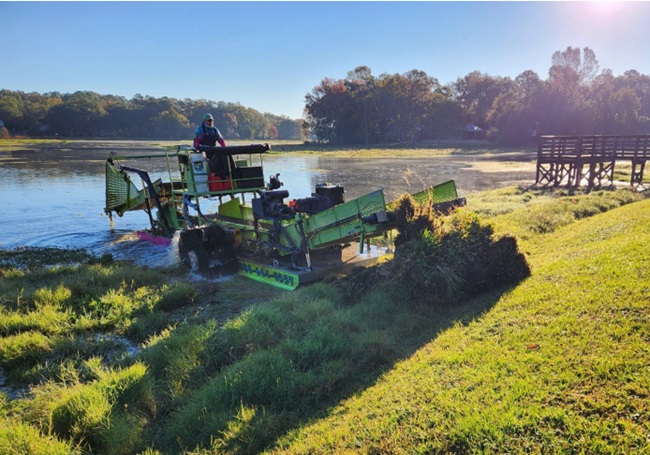The Killearn Homeowners Association (KHA) has initiated a project to clean out the vegetation that has grown in Lake Killarney over the last few years. KHA President Steve Givens told TR that the KHA Board voted unanimously to move forward with a capital project that will cost approximately $86,000 and will be paid for over a three-year period.
The project will have two phases. The first phase is the mechanical removal of “exotic nuisance vegetation” by Stones Aquatic Weed & Algae Removal, a Valdosta, Georgia based business. Stones Aquatic is removing and disposing of the larger vegetation in the lake.This approach was recommended in the “2024 Lakes Monitoring Annual Report” published by the City of Tallahassee. This work, which began during the first week of December, will be completed in February of 2025.
The second phase will include the use of herbicide treatment to further remove undesired vegetation.
Herb Harmon, a KHA Board member managing the project, told TR that once the vegetation is removed an annual maintenance plan will be devised to keep the lake from returning to its current state.
Lake Killarney, which has a surface area of 80 acres, is located within the subdivision of Killearn Estates and has a maximum depth of 8 feet and an average depth of 4 feet. As a shallow lake, Lake Killarney is more susceptible to drying out during long periods of drought or below average rainfall. When the lake bottom is dry, terrestrial grasses and plants overtake a large portion of the lake bottom. When ample rainfall occurs to refill the lake system, established terrestrial plants die and decom[1]pose. This vegetative decomposition releases stored nutrients, which can lead to the production of severe algal blooms resulting in high Chlorophyll-a and organic nitrogen concentrations.
Harmon noted that Tallahassee has experienced drought conditions from 2017 through 2023. These weather conditions have contributed to the current condition of Lake Killarney. Additionally, the Red Hill clay soils within the Killearn Chain of Lakes drainage basin naturally contributes to elevated phosphorus levels.
During the initial residential development of Killearn Estates, the lake level was regulated by pumping water into the lake. This approach kept undesired vegetation from growing in the lake. However, the permit allowing this practice expired and was not renewed. The KHA is evaluating the steps required to renew the permit.
The KHA has worked with the City of Tallahassee for years to improve the quality of Lake Killarney. However, since the lake is private, actions the city can take are limited. In 2013, an agenda item before the city noted that over the last three decades various elected officials and city staff members have held multiple discussions with representatives of the Killearn Homes Association (KHA) regarding the status of the lake.


“Lake Killarney, which has a surface area of 80 acres, is located within the subdivision of Killearn Estates and has a maximum depth of 8 feet and an average depth of 4 feet.”
Four to eight feet depth is just a big pond. What would it cost to dredge it and have a “true” lake?
The lake, is not actually a lake, it was a wet weather pond filled by runoff from the area, and from a creek coming out of Lake Tom John, it was never a “lake” until Killearn was developed and it was filled out of the aquifer to sell “lake front lots”.
Fertilizer from yards has a lot to do with the aquatic growth which is brought in by birds who have visited other lakes.
When it goes dry, it should be excavated down to its original level, anything else is just a band aid. Then leave it as a wet weather pond and let nature take care of it.
That needs to be done to Lake Jackson as well.